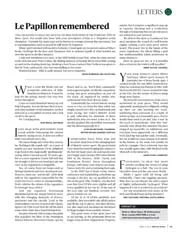
Letters, March 2019
I was delighted to read the articles on Mike Hawthorn in the February 2019 of Motor Sport, but would take issue with your description of him as a ‘forgotten world…

A new column deserves some comment from the industry upon which it reports, so here are a few I have rounded up. From Volkswagen: “We have never before seen this kind of crisis.” Toyota: “An emergency of a magnitude we have never seen before.” Mercedes-Benz top brass: “The worst crisis since World War Two” and, not to be outdone by its rival up the road, BMW: “The worst crisis BMW has faced in its history.”
That’s the bad news.
The good news is the ‘crisis’ to which they all refer is not where the industry thinks it is today. In fact, all those quotes are a little more than a decade old and came in response to the global financial collapse of 2007. We have problems today including the slowdown in China, the collapse of confidence in diesel and, of course good ol’ Brexit, but the temptation to think that just because things aren’t great means they have never been worse is to be avoided, even though for those directly affected – such as the 4500 who recently lost their jobs at JLR – it must seem that way.
What is true is that the industry is changing, faster than at any time in its history, and you can’t go through that kind of seismic upheaval without causing a considerable disturbance to the status quo. Omelettes and eggs, if you like.
It would have been helpful had government kept up with the industry and got behind the provision of a respectable charging infrastructure for this electrically powered world to which we are now irretrievably committed, but as even filling in pot-holes seems a bit of an ask, we need to manage expectations. Our 50kW public charging stations are pathetic, and that’s when they’re working. Show me a person who owns an electric car and I will show you someone who has crawled around the countryside, schedule in tatters, trying to find any way possible to put some charge in their batteries.
I’m overjoyed that, after missing out in 2018, the S F Edge Trophy for cars with an average age of 100-plus is back on the Goodwood Members’ Meeting fixture list – not least because I’m in it.
Friends who race more modern machinery (which is all of them) think I’m insane. But I know something they don’t: the people who pedal these ungainly Goliaths do so impeccably, because we all know the consequences of not doing so are unlikely to be pretty. I’ll be back in the 1921 TT Bentley, which is not an original TT car because none exists, but an identical copy created from an even earlier 3-litre that itself raced at Brooklands in period.
“Our 50kW charging stations are pathetic… when they’re working”
I expect that, once again, I’ll have the smallest engine on the grid, but the car is light and handles well. It’s odd to be saying that about a vintage Bentley, I know, but such things are relative. The car has punched well above its weight on our previous two excursions at Goodwood and I hope to be able to make it do so again.
A few days ago, someone asked when I first knew I was addicted to cars. I’d never thought about it because I grew up in a house with two elder brothers and a father even more infected by ‘the disease’ than I. To me it was a natural state. But I do remember the first time I was overcome by it.
It would have been about 1974 so I was probably eight years old, living a sheltered life between home on a Channel Island and a boarding school in Eastbourne. As a treat one exeat we took a detour past Maranello Concessionaires in Egham. The lines of Dinos and Daytonas left me reeling. I didn’t know Ferraris even came in pairs, let alone by the dozen. But then I saw something else: a dark blue Boxer sitting menacingly on the forecourt. Somewhat stunned, I did what I always did and peered through the window to see the speedometer. It read to 200mph, and that set me reeling. I staggered to the back of the car where my bulging eyes were greeted by the sight of not two or even four exhaust pipes but six. Six! How fast must a car be to need six pipes?
I had to sit down. Years later I was told I had to be physically dragged away, but I don’t remember that: just that dark blue Ferrari, those six stubby pipes and the dawning realisation that whatever this disease was, it was with me for life.
What is the most exciting car company to be working for at present? My bet is Lotus. Starved of cash and product for years, but now in the hands of the same organisation that turned Volvo from an also-ran into a front-runner, all the elements are there for it to become a car company of which not even Colin Chapman could have dreamed. And it is recruiting. To use its own words it has “new positions available across the company in multiple locations in the UK and internationally”, so you don’t even have to live in Norfolk any more. If I wanted a job in the car industry in almost any capacity, that’s where my CV would be heading first.
Perhaps things aren’t so bad as some would have us believe, after all.
A former editor of Motor Sport, Andrew splits his time between testing the latest road cars and racing (mostly) historic machinery
Follow Andrew on Twitter @Andrew_Frankel